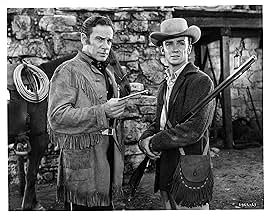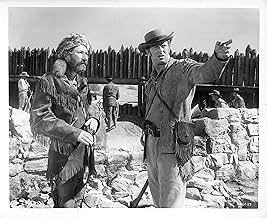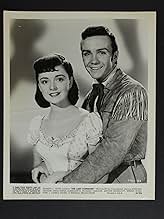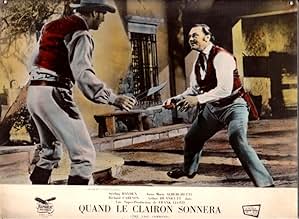PUNTUACIÓN EN IMDb
6,2/10
1 mil
TU PUNTUACIÓN
El moderado Jim Bowie lidera a los rebeldes tejanos y a Davy Crockett en una última batalla contra su viejo amigo, Santa Ana.El moderado Jim Bowie lidera a los rebeldes tejanos y a Davy Crockett en una última batalla contra su viejo amigo, Santa Ana.El moderado Jim Bowie lidera a los rebeldes tejanos y a Davy Crockett en una última batalla contra su viejo amigo, Santa Ana.
- Dirección
- Guión
- Reparto principal
Abdullah Abbas
- Townsman
- (sin acreditar)
Rico Alaniz
- Tomas
- (sin acreditar)
Reseñas destacadas
Frankly, I don't watch movies expecting to see historical accuracy. Movies are basically a commercial product marketed to earn a profit, which means pleasing as large an audience as possible. So, if there's a conflict between historical accuracy and constructing a more saleable story, we know generally which factor will prevail. That's simply the way our capitalistic system works. Thus, well-intended folks should not be surprised at the liberties taken in this supposed account of events surrounding the siege of the Alamo.
That being said, I thought the movie was very enjoyable. I thought so back in 1955, and again the other night on TMC. It's a good lively cast. Hayden may not have liked his role, but he's motivated nonetheless—catch how much he puts into the emotional exhaustion when he raps in vain on a door and then faces the camera in near collapse. That's probably the most animated this fan of Hayden's has seen him in any movie. The under-rated Richard Carlson also delivers as Hayden's rival, and of course there's the inspired casting of Hunnicutt as Davy Crockett at a time when Disney's Crockett dominated the big screen and the pop music charts too. In fact, Hunnicutt's little speech after arriving at the fort amounts to a masterpiece of down-home eloquence. And Russell Simpson's parson of-very-few- words is just the kind of no-nonsense character you'd expect to find among a band of back- woodsmen. Too bad, however, that commercial factors required Alberghetti's role. She's fine as the teenage aristocrat, but the sub-plot pairing her with the very mature Hayden amounts to the movie's biggest drawback.
One thing lowly Republic was good at is action sequences. Here the battle scenes and spectacle are outstanding—the collapsing parapet is both surprising and especially well done. For sure, the studio knew how to get the most out of limited resources, even as constraints show up around the edges, particularly with painted backdrops. Nonetheless, the enemy is treated with due respect, and I particularly liked the elegiac final scene with the traumatized women and children. It's just the kind of somber mood fitting for what has happened. Of course, Republic's reputation as a cowboy studio would never get its product much attention from either the press or the artistic community. Nonetheless, this is a surprisingly well-mounted and entertaining feature that can hold its own against bigger- budget action features of its day. Too bad, its many merits have been so generally overlooked.
That being said, I thought the movie was very enjoyable. I thought so back in 1955, and again the other night on TMC. It's a good lively cast. Hayden may not have liked his role, but he's motivated nonetheless—catch how much he puts into the emotional exhaustion when he raps in vain on a door and then faces the camera in near collapse. That's probably the most animated this fan of Hayden's has seen him in any movie. The under-rated Richard Carlson also delivers as Hayden's rival, and of course there's the inspired casting of Hunnicutt as Davy Crockett at a time when Disney's Crockett dominated the big screen and the pop music charts too. In fact, Hunnicutt's little speech after arriving at the fort amounts to a masterpiece of down-home eloquence. And Russell Simpson's parson of-very-few- words is just the kind of no-nonsense character you'd expect to find among a band of back- woodsmen. Too bad, however, that commercial factors required Alberghetti's role. She's fine as the teenage aristocrat, but the sub-plot pairing her with the very mature Hayden amounts to the movie's biggest drawback.
One thing lowly Republic was good at is action sequences. Here the battle scenes and spectacle are outstanding—the collapsing parapet is both surprising and especially well done. For sure, the studio knew how to get the most out of limited resources, even as constraints show up around the edges, particularly with painted backdrops. Nonetheless, the enemy is treated with due respect, and I particularly liked the elegiac final scene with the traumatized women and children. It's just the kind of somber mood fitting for what has happened. Of course, Republic's reputation as a cowboy studio would never get its product much attention from either the press or the artistic community. Nonetheless, this is a surprisingly well-mounted and entertaining feature that can hold its own against bigger- budget action features of its day. Too bad, its many merits have been so generally overlooked.
Studio politics prevented John Wayne from getting the role he coveted.Wayne would have to wait nearly a decade before he would put his own vision of the Alamo on the silver screen. The film is magnificent and told remarkable for its era (a) with a recognition that Mr Bowie having married into the Mexican elite had become an assimilato, a naturalized Mexicano, (b) with sympathy for the Mexican viewpoint and (c) with respect for General Santa Ana.
The Travis of this version is not nearly the superbly arrogant martinet of the Wayne film nor the dummy who matures in combat of the more recent edition.
Regrettably unlike the Wayne film, this version omits the heroine of the story who knitted the Alamo flag-- the Mexican tricolor with the legend 1824 for the liberal constitution for which the Texans fought. Cut off by the Mexicans, the Alamo defenders would never have known of the declaration of independence or the adoption of the Lone Star flag.
Yet as the story of heroism against the odds, Last Command is first rate.
The Travis of this version is not nearly the superbly arrogant martinet of the Wayne film nor the dummy who matures in combat of the more recent edition.
Regrettably unlike the Wayne film, this version omits the heroine of the story who knitted the Alamo flag-- the Mexican tricolor with the legend 1824 for the liberal constitution for which the Texans fought. Cut off by the Mexicans, the Alamo defenders would never have known of the declaration of independence or the adoption of the Lone Star flag.
Yet as the story of heroism against the odds, Last Command is first rate.
Frank Lloyd's career stretched back to the silent era--he was a major director and made films for the top studios in Hollywood. Winding up at a B studio like Republic would seem to be a step down the career ladder, but this film is actually one of Lloyd's best and one of the best to ever come out of Republic.
The studio didn't often get the services of directors of the calibre of Frank Lloyd--although John Ford and Fritz Lang had occasionally made films there--and it spared no expense on this one. The subject matter demanded a big budget, and Republic didn't stint. Thousands of extras, big sets, spectacular action scenes, robust performances--all combined to make a first-rate action picture. Sterling Hayden makes a good Jim Bowie, the always underrated Arthur Hunnicutt personifies Davy Crockett, and the cast is filled with familiar character actors--Roy Roberts, Slim Pickens, John Russell, Jim Davis--who contribute much to the overall atmosphere of the film. The setpiece of the movie, though, is the final siege of the Alamo itself, and it is spectacular. It compares well to the John Wayne version made five years later, and ranks right up there with the final battle scene in 1964's "Zulu"--expertly edited with top-notch stunt-work and special effects. Very highly recommended.
The studio didn't often get the services of directors of the calibre of Frank Lloyd--although John Ford and Fritz Lang had occasionally made films there--and it spared no expense on this one. The subject matter demanded a big budget, and Republic didn't stint. Thousands of extras, big sets, spectacular action scenes, robust performances--all combined to make a first-rate action picture. Sterling Hayden makes a good Jim Bowie, the always underrated Arthur Hunnicutt personifies Davy Crockett, and the cast is filled with familiar character actors--Roy Roberts, Slim Pickens, John Russell, Jim Davis--who contribute much to the overall atmosphere of the film. The setpiece of the movie, though, is the final siege of the Alamo itself, and it is spectacular. It compares well to the John Wayne version made five years later, and ranks right up there with the final battle scene in 1964's "Zulu"--expertly edited with top-notch stunt-work and special effects. Very highly recommended.
Made in spite by Yates, well shot and mounted, replete with an excellent cast, 'The Last Command' still remains good value even if it rather pales besides Wayne's grandiose epic of just a few years later. The much underrated Hayden is superb as "big Jim Bowie" and Hunnicutt equally as good as Davy Crockett. Hayden has the ability to appear gentle, naive, rugged and brusque all at once - something few other actors, with perhaps the exception of Spencer Tracy, managed. Unfortunately Crockett and his 29 men don't appear until some way in. With only Hayden's latent dynamism really keeping things afloat, the first half an hour of the film is rather talkative in exposition, and it drags somewhat. Consuela de Quesada (Anna Marie Alberghetti) is a limp romantic foil to Bowie - I for one would be happy to have seen her written out and the structure tightened through her absence. Ernest Borgnine plays his small role with gusto - his confrontation with Bowie a standout scene in a film full of fighting, although his later genial acceptance of Bowie's superiority as a man is perhaps emphasised by the script too much for comfort.
Steiner's music (and especially the superb title song) goes a long way in making events move smoothly towards the climax. For it's the Alamo Battle the bums on seats will have come to see, and here it is done well (although again not *as* well as Wayne would manage with considerable more time and resources later (although any comparison isn't too much to the present film's detriment).
In short this is well worth seeing, and it provides a contemporarily staged contrast to the better-known epic which was to follow. I'd still like to see an historically accurate account of the events at the mission, though...
Steiner's music (and especially the superb title song) goes a long way in making events move smoothly towards the climax. For it's the Alamo Battle the bums on seats will have come to see, and here it is done well (although again not *as* well as Wayne would manage with considerable more time and resources later (although any comparison isn't too much to the present film's detriment).
In short this is well worth seeing, and it provides a contemporarily staged contrast to the better-known epic which was to follow. I'd still like to see an historically accurate account of the events at the mission, though...
I always liked this Alamo epic better than Wayne's because it moved faster and Sterling Hayden and Arthur Hunnicutt looked like Jim Bowie and Davy Crockett might have been. Hunnicutt's death scene influenced Wayne's in his epic but I'll rate Hunnicutt's an A+ for less "operatic" posing and a more real "I'll take you to hell with me realism. The teeny bopper love angle could've of been dropped though.
¿Sabías que...?
- CuriosidadesThe melody to "The Ballad of Rock Ridge" from the western spoof Sillas de montar calientes (1974) is taken almost note for note from this film's "Jim Bowie", sung by Gordon MacRae. Coincidentally, Slim Pickens appears in both films.
- PifiasWhen Gen. Santa Ana's cavalry charges toward the Alamo, the tire tracks of the camera truck are visible in front of the horses.
- ConexionesFeatured in That's Action (1977)
- Banda sonoraJim Bowie
by Sidney Clare and Max Steiner
Sung by Gordon MacRae
A Capitol Recording Artist
Arranged by Van Alexander (uncredited)
Selecciones populares
Inicia sesión para calificar y añadir a tu lista para recibir recomendaciones personalizadas
- How long is The Last Command?Con tecnología de Alexa
Detalles
Taquilla
- Presupuesto
- 2.193.939 US$ (estimación)
- Duración1 hora 45 minutos
- Relación de aspecto
- 1.66 : 1
Contribuir a esta página
Sugerir un cambio o añadir el contenido que falta

Principal laguna de datos
By what name was La última orden (1955) officially released in India in English?
Responde




































